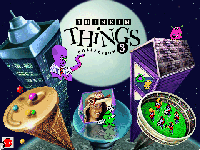




|
Review of
Thinkin' Things Collection 3
 Published by: Edmark
Published by: Edmark
Year: 1995
Suggested Age Range: 7-13
Platform Information: MAC or PC
Reviewer: Andee Rubin
Image © Edmark. Used with permission.
Is the Game Mathematical?
The main mathematical topics in Thinkin' Things 3 are logical reasoning, sorting and classifying, geometry, and ideas found in computer programming. Two puzzles -- Let's Make a Trade and Fribble Place -- embed these topics easily into fantasy settings with amusing characters and a hint of a story. Let's Make a Trade requires you to figure out a series of trades that will change several items(e.g. three tires and a candlestick) into a different set(e.g. 4 rings and a lamp) by exchanging objects for one another (e.g. a tire and a candlestick for 2 rings). This requires a good deal of planning ahead, especially at the more advanced levels. Fribble Place is a game of attributes; you have to arrange a set of Fribbles -- creatures with different hats, glasses, and bodies -- in an array of rooms so they follow a set of rules like, "No one on the first floor wears glasses." As with Let's Make a Trade, there is considerable meat to these puzzles at the higher levels. In both cases, the easiest levels are quite accessible, so even the beginner will find something interesting to think about.
The "free explore" choices are different in the way they present content. The most clearly mathematical is the Half Time activity, where you get to put together a halftime show, complete with marching band, cheerleaders, and designs on the field. To do this, you use elementary programming, e.g. sequences of commands and indications of how many times to repeat a set of instructions etc. HalfTime (and the other construction activities) also contain relatively complex examples to inspire players to go beyond a simple marching band. Successfully programming a complex show can be a challenging -- and satisfying -- experience that stretches players' ability to plan and keep track of complicated series of events.
Photo Twister is more playful and less explicitly educational. There are over twenty "twisters," each of which transforms a picture in a particular way, e.g. by stretching it horizontally or leaving footprints on it. You can create a personal piece of art by starting with one of the enclosed photos and twisting it in any number of ways. The game also challenges you to figure out how it has "twisted" a particular picture. This is a fun, creative activity, though not particularly focused on mathematical or thinking skills.
Carving BLOX, the physics construction area, gives players tools such as ramps and springs and the ability to change gravity and friction. The idea is to create a landscape in which balls of various colors move according to the laws of physics. While there is a significant amount of serious physics in this activity, it will be beyond many players. The examples provided are helpful, but it is difficult to figure out how to create them with the available tools. The lack of a helpful coach (which there is in HalfTime) makes this a hard activity to get into.
Is the Game Equitable?
Most of the characters in Thinkin' Things Collection 3 are cartoon characters, with only incidental and sometimes indeterminate gender. While Stocktopus, the main broker in Let's Make A Trade, is male, many of the other traders are female. This game is set in an international context; each trader lives in a different country, so there is some cartoonish acknowledgment of cultural diversity. HalfTime provides both male and female characters as potential "marchers." The only slight quibble is with the stereotypical view of gender; the only specifically female characters are cheerleaders, while the football players are boys.
Because there is no hand-eye coordination required and no time pressure at all, the activities in Thinkin' Things Collection 3 are ideal for collaboration. The design areas -- especially HalfTime -- lend themselves easily to joint creations; it is easy to imagine comments like, "Let's make them go in circles now." These kinds of activities are likely to be especially appealing to girls.
The activities are also accessible to players at different levels; the easier levels of the two puzzles are quite straightforward, while the harder ones are significantly challenging. Of course, players can use the design areas as they choose, from simple to complicated. (The only exception to this is the physics area, which may be incomprehensible to some.)
Is the Game a Good Game?
In some ways, Thinkin' Things Collection 3 is less a game than a collection of puzzles and activities. There is no story to speak of and the characters have little personality or individual appeal. There are no real goals and almost no way to construe the activities as competitive. The activities stand or fall on their own. There is enough variety here to be attractive to many children, but the relative placidity of this collection may pale in contrast to games with more of a narrative, compelling characters, and motivating goals.
For a child for whom being successful is important, this would be a appropriate choice. The activities designed specifically to ensure success. There's no way to "lose," and if you're stuck, the program offers hints that are often quite useful (e.g., this Fribble doesn't live here) while never punishing or even chiding the unsuccessful player.

Back to the top of the page
|



